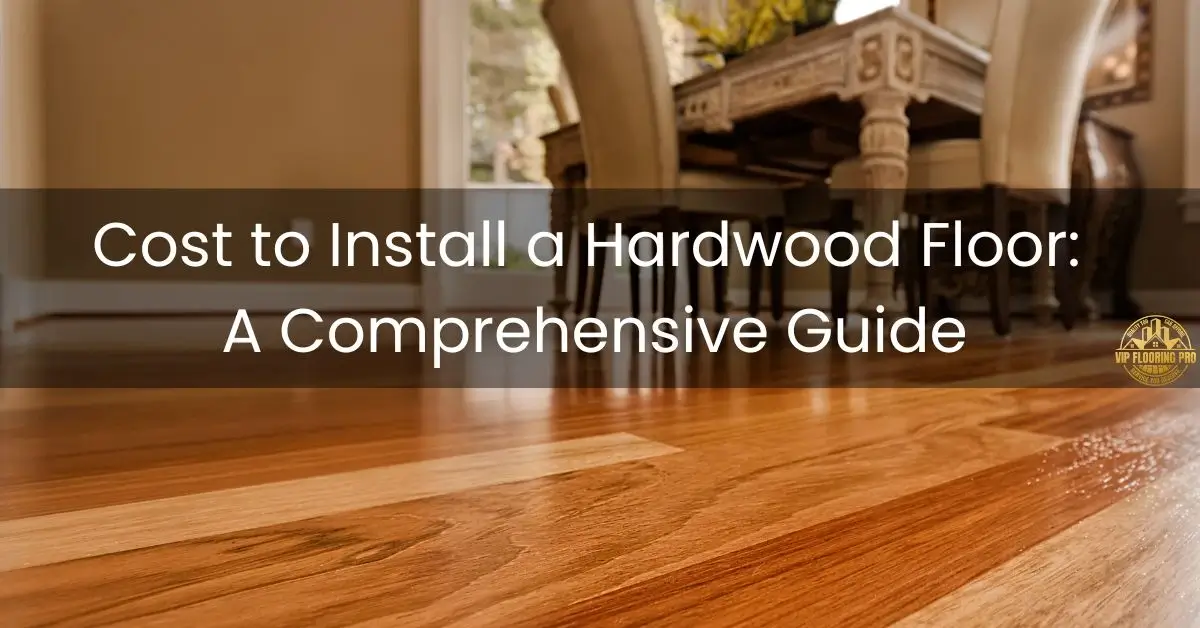Hardwood floors are one of the simplest choices for homeowners, and once, they were a common feature in family houses. Their old style and long-lasting strength make them a perfect choice that is nearly unbeatable. So, before you start your renovation, you must consider the cost of installing a hardwood floor. This comprehensive guide will tell you the factors on which the cost of installing a hardwood floor depends. So, let’s dive in.
The Cost To Install Hardwood Floor
Hardwood flooring mainly costs around $7 to $25 per square foot. Hardwood flooring materials alone range from $4 to $15, depending on the type and wood species. Wood flooring costs between $1,000 and $6,000 to install in a single room or $14,000 to $50,000 for a 2,000-square-foot home.
Area size is one of the most critical factors in determining the cost of hardwood flooring. The larger the area, the more expensive the installation will be. For example, with the following area sizes, the cost would be:
- 150 square feet: $1,050 – $3,750
- 250 square feet: $1,750 – $6,250
- 500 square feet: $3,500 – $12,500
- 1,000 square feet: $7,000 – $25,000
- 1,500 square feet: $10,500 – $37,500
- 2,000 square feet: $14,000 – $50,000
These costs change depending on the hardwood type and the installation’s difficulty. The more square footage you need, as the area gets more significant, both the materials and installation costs increase. Want to install hardwood floors on slab? Check out our article.
Hardwood Flooring Material Costs
Here are some price factors for hardwood flooring materials.
Type of woods: Stronger types of wood, like White Oak, Walnut, and Teak, are usually more expensive.
Cheaper woods, like red oak, maple, and pine, maybe less intense than the more expensive ones, but they still get the job done.
Appearance: You will also need to consider the types of grain, texture, and finish of the wood planks. The final look will depend on these factors and the length of the boards.
Width of planks: Because of their thickness, some wood can be cut in a particular way, so the thicker the wood, the more expensive it will be.
Cost of Hardwood Flooring by Size
The size of your room can also significantly affect the cost. Smaller rooms typically cost between $600 and $1,200, while a larger task, such as installing hardwood floors in a 4,000-square-foot home, can quickly reach a six-figure price tag, ranging from $52,000 to $100,000
Pros And Cons of Expensive and Cheap Hardwood Floor Installation

Here are the Pros and Cons of Expensive and Cheap Hardwood Floor Installation
Expensive Installation
These are the pros and cons of Expensive hardwood floor installation
Pros:
Higher Quality Materials:
Expensive installations often come with premium hardwood, improving durability and aesthetics.
Expert Craftsmanship:
Professional, experienced installers can provide better results, ensuring the floor is perfectly laid.
Long-Term Value
High-quality installation can increase your floors’ durability, potentially saving you money on repairs or replacements in the future.
Warranty and Support:
Premium services usually offer strong warranties, giving you peace of mind if something goes wrong.
Better Aesthetics:
You may have access to more stylish and rare hardwood types, offering a modern look.
Cons:
Higher Upfront Cost:
Expensive installation can have a significant initial cost, which may only fit some people’s budget.
Longer Wait Time:
Premium services may be booked, leading to longer wait times before your project begins.
Overkill for Some Homes:
Sometimes, a high-end floor may not be necessary for the home’s value or usage, making it a less practical choice.
Cheap Installation:
These are the pros and cons of cheap hardwood floor installation
Pros:
Lower Upfront Cost:
The most obvious advantage is the savings, which can be helpful if you’re on a tight budget.
Faster Installation:
Depending on availability and the project’s simplicity, budget installers can complete the job more quickly.
Suitable for Temporary Solutions:
Suppose you’re planning to sell the home soon. In that case, cheaper installation can be a good way to update the flooring without making a significant investment.
Cons:
Lower-Quality Materials:
You may work with lower-quality hardwood, resulting in a less durable or attractive floor.
Potential for Poor Workmanship:
Inexpensive installation may involve less experienced contractors, leading to mistakes like uneven surfaces or poor cuts.
Less Durability:
Cheaper floors can get damaged faster, leading to more frequent repairs or replacements.
Limited Selection:
You might need access to premium hardwood options, which could impact the floor’s aesthetic appeal.
Our suggestion:
However, some cheap contractors can be better than expected. You can always give them a try according to your budget.
Affordable options for hardwood flooring

To save some money, you must research your stuff correctly so you can easily decide on your own.
Here are affordable options for hardwood floor installation. This information can easily save some of your money.
1: Restore your current wood floors
This is the most effective and only way if you have solid hardwood floors or specific kinds of engineered wood. You may need to restore the laminate floors. Refinishing gives the best return on investment. So, if your house already has hardwood and you want to change the color, refinishing is the most affordable choice.
2: Research Materials
Types of wood play a massive role in cost, so it’s essential to research the prices of different wood flooring materials.
3: Remove your stuff
Anything you can do to make it easier for the workers will save money. Moving and covering your furniture would relieve the installers of a burden, allowing them to work easily. Your cost would also be reduced.
Compare the cost of having your contractor move your furniture to the cost of hiring movers. If you’re renovating the whole house, it might be worth hiring professional movers and renting storage until the work is finished.
4: DIY
You might consider doing part or all of the job yourself, but only if you have experience installing hardwood floors. If not, it could take more if you make mistakes and need to hire someone to fix them later. It’s usually better to hire a pro to save time and money.
Conclusion
Hardwood floors are popular because they last a long time and look great. The cost to install them depends on the size of the room, the type of wood, and how hard the job is. Expensive options last longer and look better but cost more upfront. Cheaper options save money at first but may need repairs sooner. To save, you can refinish old floors, shop for affordable wood, or do some work yourself. Choose what fits your budget and needs.
For more inquiries, contact us on Instagram
FAQs:
Q1: What are the hardwood flooring installation methods?
A: There are three main ways to install hardwood floors: nail-down, glue-down, and floating. Nail-down uses nails or staples to secure the planks to a wooden subfloor. Glue-down sticks the planks to the subfloor with adhesive. Floating floors don’t need nails or glue; the planks click together and sit on top of the subfloor. Each method has different costs and works best with particular subfloors.
Q2: Does the cost change with the installation method?
A: Yes, installation methods affect the cost. Nail-down is usually the cheapest, while glue-down and floating methods can be more expensive, depending on the complexity and materials used.
Q3: What is the most affordable hardwood flooring option?
A: Cheaper hardwood options like pine or maple are more affordable than stronger woods like walnut or oak. Researching prices and comparing wood types can help you find the best deal.
Q4: Can I install hardwood floors on my own to save money?
A: While DIY installation can save on labor costs, it’s recommended only if you have experience. Mistakes during installation can lead to higher costs in repairs or future maintenance.




